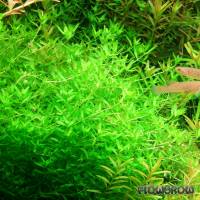



Baby tears is one of two Hemianthus species that has been cultivated in aquaria for a long time, known under the name "Hemianthus micranthemoides". Recently it came out that neither belongs to this species. The better-known of these two aquarium plants was identified in early 2011 by Cavan Allen (USA) as Hemianthus glomeratus. The species of the other plant, which is presented here as Hemianthus sp. "Amano Pearl Grass", could not be identified yet. It differs from Hemianthus glomeratus in some characteristics, in its emersed as well as in its submersed form (see below) [1, 4].
True H. micranthemoides has probably never been cultivated in aquaria, and may be extinct in nature.
Takashi Amano uses this Hemianthus under the name "Pearl Grass" in his aquascapes. Neil Frank (USA), who got this plant in 1995 from T. Amano, thus calls it Hemianthus sp. "Amano Pearl Grass" [2]. Amongst aquarists in Germany it has become known as Hemianthus sp. "Goettingen" in the last years. Hans-Georg Kramer (2009) gave this fresh green plant the German name Smaragd-Perlenkraut, which translates to emerald baby tears [3].
Sometimes, this plant is erroneously sold as Hemianthus callitrichoides "Cuba" in trade. The reason for this might be the fact that the emersed forms of H. callitrichoides "Cuba" and this hitherto unidentified Hemianthus look very much the same, and might be confused with each other from time to time in aquatic plant nurseries. However, the difference becomes quite clear when the plants develop submersed shoots.
Commercially available "H. micranthemoides" (H. glomeratus) has its leaves mostly in whorls of three or four, as well in its emersed as in its submersed form. Its submersed leaves are generally stronger bowed down as those of H. sp. "Amano Pearl Grass".
As a rule, the leaves of H. sp. "Amano Pearl Grass" are opposite (2 leaves per node). Its emersed leaves are a little darker and more rounded with a hairier margin than those of H. glomeratus under the same conditions. As mentioned above, emersed H. sp. "Amano Pearl Grass" looks confusingly similar to emersed Hemianthus callitrichoides "Cuba". The submersed leaves are straighter than those of H. glomeratus, but have more or less the same shape.
Its growth habit resembles that of Hemianthus glomeratus, however, H. sp. "Amano Pearl Grass" has a stronger tendency to sprout horizontal or slanted upright shoots. Groups of this plant look a bit more irregular and less "orderly" than those of H. glomeratus [4].
This Hemianthus is comparable to Hemianthus glomeratus regarding aquarium cultivation and use in layouts, but seems to grow a little faster and to be more undemanding. However, if CO2 is insufficient its shoot tips tend to stop growing altogether, and grey lime deposits may form on the leaves (due to biogenic decalcification). It has also been reported to be susceptible to nitrate concentrations of over 10 mg/l [3]. Moderate light is sufficient, however, under more intensive light it develops a bushier growth habit and is easier to keep low. A flat carpet in the foreground is best realised with plants that were precultivated emersed. [5].
<a href="https://www.flowgrow.de/db/aquaticplants/hemianthus-sp-amano-pearl-grass" target="_blank"><img alt="Hemianthus sp. "Amano Pearl Grass"" title="Hemianthus sp. "Amano Pearl Grass"" src="https://www.flowgrow.de/db/widget/aquaticplants/hemianthus-sp-amano-pearl-grass" /></a>
[url=https://www.flowgrow.de/db/aquaticplants/hemianthus-sp-amano-pearl-grass][img]https://www.flowgrow.de/db/widget/aquaticplants/hemianthus-sp-amano-pearl-grass[/img][/url]
[widget=aquaticplants/hemianthus-sp-amano-pearl-grass]Hemianthus sp. "Amano Pearl Grass"[/widget]